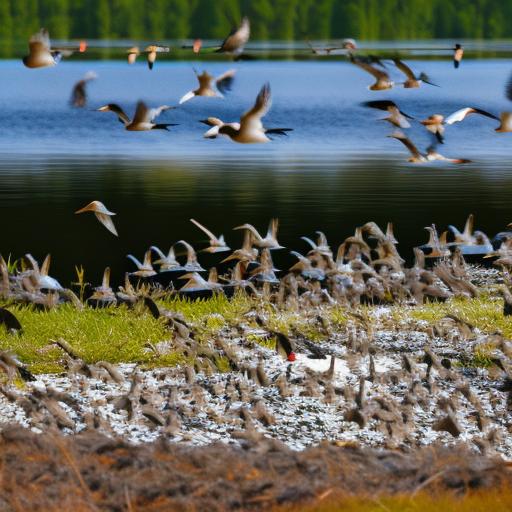Geese are known for their strong migratory instincts and their tendency to return to the same nesting and feeding grounds year after year. They are also highly social animals, often traveling in large flocks and exhibiting strong family bonds. Geese are herbivores and are attracted to areas with abundant grass and water sources. They are also highly territorial and will aggressively defend their nesting sites and young goslings.
Geese are also known for their adaptability and intelligence, making them a challenging nuisance for property owners. They are quick to learn and can become habituated to certain areas, especially if they find a reliable food source. Understanding the behavior of geese is crucial in developing effective strategies for managing their presence and minimizing conflicts with humans. By understanding their habits and motivations, property owners can implement targeted solutions to deter geese from causing damage and creating safety hazards.
Key Takeaways
- Geese are territorial and protective of their nesting areas, which can lead to aggressive behavior.
- Physical barriers such as fences and netting can effectively prevent geese from accessing certain areas.
- Repellents and deterrents like motion-activated sprinklers and reflective tape can discourage geese from settling in an area.
- Sound and visual distractions such as predator decoys and loud noises can help keep geese away from unwanted areas.
- Encouraging natural predators like dogs or installing nesting platforms for birds of prey can help control geese populations.
- Implementing a strict no-feeding policy can help reduce the attraction of geese to an area.
- Seeking professional assistance from wildlife management experts can provide effective and humane solutions for managing geese behavior.
Implementing Physical Barriers
One effective way to manage geese on a property is by implementing physical barriers to prevent them from accessing certain areas. This can include installing fences, netting, or other structures to block off ponds, lawns, and other areas where geese tend to congregate. Physical barriers can be particularly effective in preventing geese from nesting in unwanted areas, as they rely on open spaces near water for nesting sites.
In addition to traditional barriers, there are also innovative solutions available, such as floating barriers that can be installed on bodies of water to prevent geese from accessing certain areas. These barriers are designed to create an unstable surface that makes it difficult for geese to land and take off, effectively discouraging them from using the area as a feeding or nesting site. By implementing physical barriers, property owners can effectively control the presence of geese on their property and minimize the damage they cause.
Using Repellents and Deterrents
Another effective strategy for managing geese is by using repellents and deterrents to discourage them from congregating on a property. There are a variety of commercial repellents available that are designed to create an unpleasant environment for geese, making them less likely to stay in the area. These repellents can include chemical sprays, visual deterrents, and even predator decoys that mimic natural threats to geese.
In addition to commercial repellents, there are also natural deterrents that can be used to discourage geese from staying in certain areas. This can include planting tall grasses or shrubs around bodies of water to create an unappealing environment for geese to nest and feed. By using a combination of repellents and deterrents, property owners can effectively manage the presence of geese on their property without causing harm to the birds or the environment.
Employing Sound and Visual Distractions
Geese are highly sensitive to sound and visual stimuli, making them susceptible to being deterred by these types of distractions. One effective strategy for managing geese is by employing sound and visual deterrents to create an environment that is unappealing to them. This can include using devices that emit loud noises or flashing lights to scare away geese from certain areas.
In addition to electronic devices, there are also natural sound and visual deterrents that can be used to manage geese on a property. This can include using trained dogs to patrol the area and deter geese from staying in the vicinity. By employing a combination of sound and visual distractions, property owners can effectively manage the presence of geese on their property without causing harm to the birds or the environment.
Encouraging Natural Predators
One natural way to manage geese on a property is by encouraging the presence of natural predators that prey on geese. This can include attracting birds of prey such as hawks or owls, which are known to feed on geese and can help control their population in a given area. By creating an environment that is attractive to natural predators, property owners can effectively manage the presence of geese without causing harm to the birds or the environment.
In addition to attracting natural predators, property owners can also implement strategies to make it more difficult for geese to detect and escape from potential threats. This can include creating tall grasses or shrubs around bodies of water to provide cover for predators, making it easier for them to hunt and deter geese from staying in the area. By encouraging natural predators, property owners can effectively manage the presence of geese on their property in a way that is environmentally friendly and sustainable.
Establishing a No-Feeding Policy

One common reason why geese congregate in certain areas is due to the availability of food sources. Property owners can effectively manage the presence of geese by establishing a no-feeding policy that prohibits the intentional feeding of geese on their property. This can help reduce the attractiveness of the area for geese and discourage them from staying in the vicinity.
In addition to implementing a no-feeding policy, property owners can also educate residents and visitors about the negative impacts of feeding geese and encourage them to refrain from doing so. By raising awareness about the potential harm caused by feeding geese, property owners can help create a community-wide effort to manage the presence of geese in a responsible and sustainable manner.
Seeking Professional Assistance
For property owners facing persistent issues with geese, seeking professional assistance from wildlife management experts can be an effective solution. These professionals have the knowledge and experience to develop targeted strategies for managing geese on a property while minimizing harm to the birds and the environment. They can conduct thorough assessments of the property and develop customized management plans that address the specific needs and challenges of the situation.
In addition to developing management plans, wildlife management experts can also provide ongoing monitoring and maintenance services to ensure that the strategies implemented are effective in managing the presence of geese on the property. By seeking professional assistance, property owners can gain access to the expertise and resources needed to effectively manage geese in a way that is responsible and sustainable.
In conclusion, managing the presence of geese on a property requires a comprehensive understanding of their behavior and motivations. By implementing targeted strategies such as physical barriers, repellents and deterrents, sound and visual distractions, encouraging natural predators, establishing a no-feeding policy, and seeking professional assistance, property owners can effectively manage the presence of geese while minimizing harm to the birds and the environment. With careful planning and implementation, it is possible to create a harmonious coexistence with geese while protecting property and public safety.
Looking for ways to keep geese off your lakefront? Check out this informative article on how many eggs geese lay. Understanding the behavior and breeding habits of geese can provide valuable insights into managing their presence near your property. Additionally, if you’re interested in raising other poultry alongside geese, you might also find this article on keeping guinea fowl with chickens helpful. And for those looking to provide a secure and convenient housing solution for their poultry, the SnapLock chicken coop could be a great option.
Meet Walter, the feathered-friend fanatic of Florida! Nestled in the sunshine state, Walter struts through life with his feathered companions, clucking his way to happiness. With a coop that’s fancier than a five-star hotel, he’s the Don Juan of the chicken world. When he’s not teaching his hens to do the cha-cha, you’ll find him in a heated debate with his prized rooster, Sir Clucks-a-Lot. Walter’s poultry passion is no yolk; he’s the sunny-side-up guy you never knew you needed in your flock of friends!







